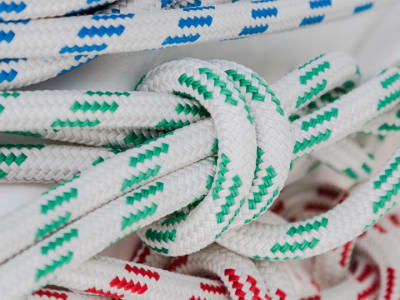
Whether you’re brand new to the yachting scene or a salty wind-seeker who’s been around the dock a time or two, learning how to properly tie knots, and knowing when to use them, is one of the most invaluable skills any sailor can acquire. To make your chartering life as easy as possible, our in-house expert John Keyes has identified the top five basic sailing knots that you need to master to look and feel like a confident captain onboard.
So, let’s get started! To practice the fine art of tying these essential sailor knots, simply find a rope or household equivalent and follow along with the how-to videos or step-by-step instructions below.
Cleat Hitch Knot
You MUST know how to tie a Cleat Hitch knot in order to get your boat secured to a dock or a mooring buoy.
- Beginning on the side farthest from where the line starts, wrap around the base of the cleat.
- Complete a figure-8 around the cleat. Repeat two or three times if the line will be under a lot of pressure.
- Add a hitch to the final turn to secure it by making a loop with the tail end underneath, then hooking it around the cleat, and pulling it taut.
Bowline Knot
The Bowline (pronounced bo-lin) is the king of knots in the boating world when you need a loop at the end of a line, and is often used to tie the jib sheet to the sail. The Bowline is very secure and easy to untie, even after carrying weight or enduring heavy “pulling”.
- Make a turn in the standing part of the line to form a loop. Tip: When making this critical loop, the running part of the line must pass over the standing part and the loop should be to the inside of the “bight”.
- Guide the end of the line up through that loop.
- Wrap the line around the standing part and run back down through the loop.
- Hold onto the end and pull the knot tight.
Clove Hitch Knot
The fastest way to attach a fender to a life line is with a Clove Hitch knot, which allows the fender to be raised or lowered without completely untying it.
- Run the end of the line around the post or whatever you’re attaching it to.
- Cross the line over itself and pass it around the post a second time.
- Loosen the last loop a little bit, slide the end under, and pull it taut to secure your knot.
Stopper Knot
All lines on a sailboat must have a Stopper knot, especially the halyard. When you let the main halyard go and the mainsail drops fast, the weight of the line can pull a halyard right out of the jamb cleat. Not to mention, retrieving a lost sail control line can be challenging to say the least.
- Make a small loop at the end of the line by passing the tag end over the standing line.
- Tie an overhand knot around the standing line and pull it taut.
- Run the tag end through the loop end.
- Pull the tag end all the way through and slide the knot down until tight.
- Pull both ends tight to secure the knot.
How to Coil a Line
In addition to being able to secure various knots while underway and on the dock, it is just as important to know how to store dock lines properly so that they are easily ready for the next use.
Keep in mind that repetition is key for muscle memory so don’t give up if you’re not a knot expert quite yet. After so many times, tying tried-and-true sailing knots will be a habit that you’ll do without thinking – just like tying your shoes!
About the Author:

I started sailing in 1969 on Lake Ontario. My dad had been sailing since 1930, had lived aboard a 30’ ketch for a couple years just prior to WWII and wanted to get back to the sailing life. I learned how to “hand, reef and steer” onboard a Westerly 25. In 1973 we bought a 35’ Dickerson ketch in South River near Annapolis and moved onboard for 4 years making three round trips on the ICW between the Annapolis area and Marathon FL Keys plus two one month trips to the Bahamas. I joined the Coast Guard in 1977 and spent close to 5 years at sea in the navigation division. I was a licensed capt running sailing charters between 1988 to 1996 out of New Port Richey FL also working as the base manager of the FL Keys operation for a year. I started working at The Moorings in Jan 1998 and have been the Owner Reservations agent since 1999. Right after 9/11 I joined the Coast Guard Auxiliary and am a qualified crew and boat coxswain.
Contributor
Leslie Montenegro
Step Aboard Here
Start your experience with The Moorings on land and sign up to receive e-mails from us about yachts, offers and destinations.
By clicking 'Sign up' you confirm that you have read and understood our Privacy Policy and consent to our use of your information.



